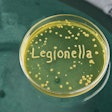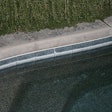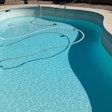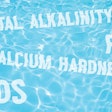

It's hard to say which part of pool service is the best, the customers, the traffic, the dogs, the midday heat... but near the top of the list is the sense of mystery and wonder. Even the most experienced pool pros find themselves looking at a menacing streak of dark matter growing on the side of the pool and asking, "What is that?"
In the spirit of investigation and pool chemistry education, we enlisted two top experts in the field, Roy Vore and Jenn Huang, to look at real life pool care problems.

1. CAN ANYONE TELL ME WHY THIS RUST KEEPS COMING BACK? SALT POOL, INDOOR, HIGH HARDNESS.
There are some easy-to-spot clues that are a good place to start looking for answers here. The rust is obvious, BUT this looks fluffier than the usual garden variety of rust.
Given that this is a salt pool, the first go-to is high pH, of course. What is the pH and is it being controlled properly? The next thing to consider is the high calcium, which obviously suggests less-than-ideal water management. If calcium is high and pH is typical (though not maintained by automated control), no calculator is needed to know that LSI is almost certainly through the roof.
So, why is there corrosion if the water is in the 'scaling range'? Since there were no indications of scaling reported, the next thing to do is take a step back and look at the light ring itself. Likely, it has been in use for a number of years and the anti-corrosion plating is pitted, allowing the pool water to react directly with the steel surface. Chances are, the coating against the glass is in even worse shape and that is where the fluffy-looking rust is coming from.
However, rust in pools usually occurs under acidic conditions, rather than alkaline conditions. Iron does react with excessive hydroxide ions to form iron hydroxide deposits, which are fluffy and are easily wiped away. Based on the chemistry of iron, the fluffy brown material is iron hydroxide. Therefore, the light ring should first be replaced.
If the light ring is deteriorated and past its service life, it's probably not the only component in that condition. So what else needs to be replaced? Are the skimmer and pump baskets cracked? How old is the sand? It is probably time to look at everything, including the GFCI and grounding for all the electrical.
It is fairly common to find residential service pools with grounding that is either missing or disconnected. In addition, the water balance issue should be addressed. Consider possible causes for the high calcium for this indoor pool. Is the pool being run on calcium hypochlorite? Or, is the high calcium the result of accumulation due to high evaporation, common with some indoor pools? It is possible that the fill water is very hard. What is the TDS level? What is the TDS now compared to when it was first balanced? Given that the calcium is high, it is very likely that the TDS is sky high. But, remember the rule: taking remedial action when the TDS rises 1500 ppm or more only applies after the salt level is considered. It is quite likely that this pool needs a partial drain and refill in order to lower the calcium (and TDS), which may notably improve water balance maintenance.

2. ANY IDEA WHAT COULD BE CAUSING THESE KINDS OF STAINS?
Given just a photo of the pool, we are looking at several possible causes. Without knowing how fast the stains formed or (perhaps) fade, a good suspect for spots like these is an organic issue. What kind of trees are there around the pool? The stains appear to be localized, so they could be from the tannins in leaves. Some of the tree fruits can make awful spots pretty quickly. For example, the hulls of pecans and especially the ones on black walnuts can make a big mess that will stain light-colored plaster. Stains from these can take a while to bleach out on their own.
Before treating, a standard stain test kit should be used to determine if the stains are metal or organic. Then, match the treatment to the type of stain. If it does turn out that they are organic stains, the solution is to limit what is causing them. Routinely cleaning the pool may be the answer to prevention. For those who do not like to do netting, there are many good robotic cleaners that would keep the tree debris out and the pool looking nice.
Organic stains will eventually fade with just normal chlorine residuals. Recently, Roy took over a 55,000-gallon, white plaster community pool that had dozens of almost perfect prints of oak leaves scattered across the deep end. That pool had two 40-foot tall oak trees right next to the deck on the deep end. The previous service company had been less than enthusiastic about cleaning the pool during prime season and when fall hit, the company disappeared altogether.

Tannins from the leaves also discolor the water, as shown above. When this close-up photo was taken, a major windstorm had come through the previous week. This pool was closed for the season, and it had about 4 ppm of measured free chlorine. The discolored water was from tannins that had leached from the leaves. Understanding what surrounds the pool is vital in planning service, especially in the fall.
This article first appeared in the March 2023 issue of AQUA Magazine — the top resource for retailers, builders and service pros in the pool and spa industry. Subscriptions to the print magazine are free to all industry professionals. Click here to subscribe.











































